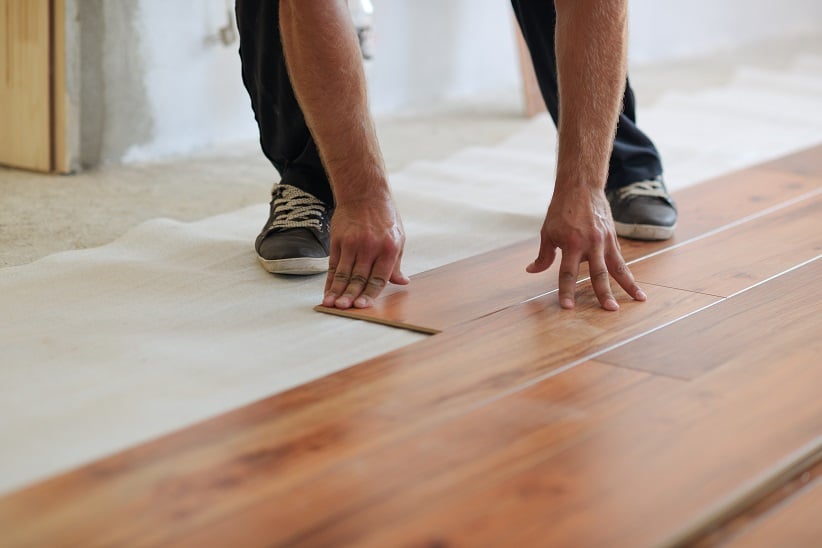Imagine this: You’re finally ready to give your home a fresh look. Maybe you’ve dreamt of gleaming hardwood floors or the sleek look of modern tiles. But then you realize – you already have vinyl flooring! The thought crosses your mind, “Can I just install new vinyl over the old?”

Image: jjvs.org
It’s a question many homeowners ask, and the answer isn’t as simple as a yes or no. It depends on the condition of your current flooring and the type of vinyl you’re planning to install. This guide dives into the world of vinyl flooring over vinyl flooring, exploring the benefits, challenges, and essential factors to consider before embarking on this DIY project.
Understanding the Basics: Vinyl Flooring and Its Layering Potential
Vinyl flooring has become a staple in homes across the country. It’s durable, water-resistant, and comes in a vast array of styles and colors. But when it comes to installing new vinyl over existing vinyl, the key lies in understanding the types of vinyl and their compatibility.
There are two main types of vinyl flooring:
- Sheet vinyl: This type comes in large, continuous sheets that are glued down to the subfloor.
- Luxury vinyl plank (LVP) and tile (LVT): These are individual planks or tiles that can be installed using adhesive, click-lock systems, or floating methods.
The ability to layer vinyl flooring depends on the type of existing vinyl and the new vinyl you choose. With sheet vinyl, it’s generally not recommended to install new flooring directly over it. This is because sheet vinyl tends to be less stable and can cause the new flooring to become uneven or buckle over time.
However, LVP and LVT offer more flexibility. These planks or tiles can be installed over existing vinyl flooring, but certain factors should be taken into account.
Factors to Consider When Layering Vinyl Flooring
Before you jump into a vinyl flooring layering project, consider these key factors:
- Condition of existing vinyl: If your existing vinyl is damaged, uneven, or has significant bumps, you may need to remove it before installing new flooring. If it’s in good condition, you’re likely in good shape!
- Thickness of existing vinyl: A thicker layer of existing vinyl can contribute to unevenness under the new flooring. Thicker vinyl may also make it difficult to achieve a level surface.
- Type of new vinyl: LVP and LVT are more versatile for layering than sheet vinyl, but even with these, certain considerations apply.
- Desired finish: Choosing a flooring style that compliments or contrasts existing vinyl is a design element to factor in.
- DIY confidence: Layering vinyl flooring requires some skill and precision. If you’re not confident in your DIY abilities, it’s best to consult with a professional.
Steps to Successfully Layering Vinyl Flooring
If you decide to layer vinyl flooring, here’s a general outline to guide you through the process:
1. Assess Your Existing Flooring: Carefully inspect your current vinyl flooring. Look for any damage, unevenness, or loose sections. If you find any significant issues, it’s best to remove the existing flooring completely.
2. Prepare the Surface: Regardless of the existing vinyl type, cleaning the surface thoroughly is vital. This involves removing dirt, debris, and ensuring it’s dry. You can use a broom, vacuum cleaner, and a damp mop.
3. Measure and Plan: Begin by measuring the room carefully to determine the amount of flooring required. Ensure your new vinyl planks or tiles align with your existing flooring to create a consistent look.
4. Choose the Right Adhesive: Not all adhesives are created equal! You need to select a vinyl-specific adhesive that will provide a strong bond. Follow the manufacturer’s instructions carefully for proper application.
5. Start Laying the Flooring: Begin at the farthest point from the entrance of the room. Using a tape measure and level, ensure each plank or tile is properly aligned. Leave a small gap between the edges of each piece to allow for expansion and contraction.
6. Seal and Finish: Once the flooring is laid, let it cure according to the adhesive manufacturer’s instructions. You may need to seal the seams with caulk for better waterproofing.

Image: 50floor.com
Professional Guidance and Alternatives
If you’re unsure about tackling a vinyl flooring layering project, consulting with a professional flooring installer is always recommended. They can assess your specific situation and provide expert guidance on the best course of action. They can also help identify potential challenges and ensure a smooth, professional installation.
If the existing vinyl flooring has significant issues or you’re simply not comfortable with layering, there are always alternative solutions:
- Remove the existing vinyl flooring: This might be the most reliable option but requires more time and effort.
- Consider other flooring options: Explore alternatives like laminate, engineered hardwood, or tile if you’re unsure about layering vinyl.
Can You Install Vinyl Flooring Over Vinyl Flooring
In Conclusion: Unleashing Your Home’s Potential
Ultimately, the decision of whether to install new vinyl flooring over existing vinyl depends on individual needs and preferences. If you decide to embark on this project, careful planning and following best practices for flooring preparation are key. Always prioritize safety and factor in the potential challenges during the process.
With the right approach, layering vinyl flooring can be a cost-effective and stylish way to refresh your home. Not only can this save you money, but it can also be a fun and rewarding DIY project that elevates your home’s ambiance. So, if you’re exploring flooring options and considering layering vinyl, remember to educate yourself, weigh your choices, and make informed decisions for your home’s beautiful transformation.






